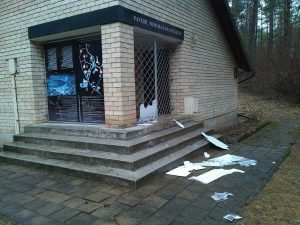- March 15, 2014
- 268
The Genocide Museum in Ponary devastated

In the morning of 15th March, the visitors of the place of remembrance in Ponary were hot on the trail of another act of devastation in that place. This time it was the building of the Genocide Musem, of which one flank had been broken off and the information board on the history and perpetrators of the Ponarska Crime had been smashed, while on the second flank the board of the plan of the place of remembrance in Ponary had been severely damaged. It is possible that this act of destruction have been linked to the celebrations of the Day of the Restoration of Independence of the Republic of Lithuania on March 11th, during which, across the centre of Vilnius, a traditional march takes place. During the march you can see the Nazi symbolism demonstrated as well as hear the xenophobic slogans chanted. With this march has been probably associated another act of vandalism having taken place last week – when in Jaszuny the unknown perpetrators tore the street signs out of the houses.
This was not the first act of devastation, whose victim fell the place of remembrance in Ponary. The monument dedicated to the victims of the Crime in Ponary being of Jewish origin has been regularly devastated, and in August “The Vilnius Kurier” informed about the theft of the metal gate from the Polish quarter memorial, that has still not be restored to its place.
The Ponarska Crime took place in 1941-1944 and took lives of more than 100 thousand people of mainly Jewish and Polish nationality, mostly the citizens of the Republic of Poland. Among the victims there was a flower of the contemporary population of Vilnius – doctors, teachers, officers, lawyers, clergymen, university professors, scouts. The majority of Polish people, before being transported to Ponary for their execution, went through serious investigation with tortures in the police custody on Lukiszki – today the Genocide Museum has been located there, and before there had been the quarters of the Gestapo and Saugumo policies – the leaders of the genocide. Executions had been carried out by the unit called “Ypatingas būrys”, made up of volunteers originating mostly from the army of interwar Lithuania and the Lithuanian Riflemen’s Union – that was why they had been called the “szaulis”. Most of the criminals had never been brought to justice, or punished.
Source: http://kurierwilenski.lt/2014/03/15/zdewastowano-muzeum-ludobojstwa-w-ponarach/
Tłumaczenie by Roksana Kasperek w ramach praktyk w Europejskiej Fundacji Praw Człowieka, www.efhr.eu. Translated by Roksana Kasperek within the framework of a traineeship programme of the European Foundation of Human Rights, www.efhr.eu.

